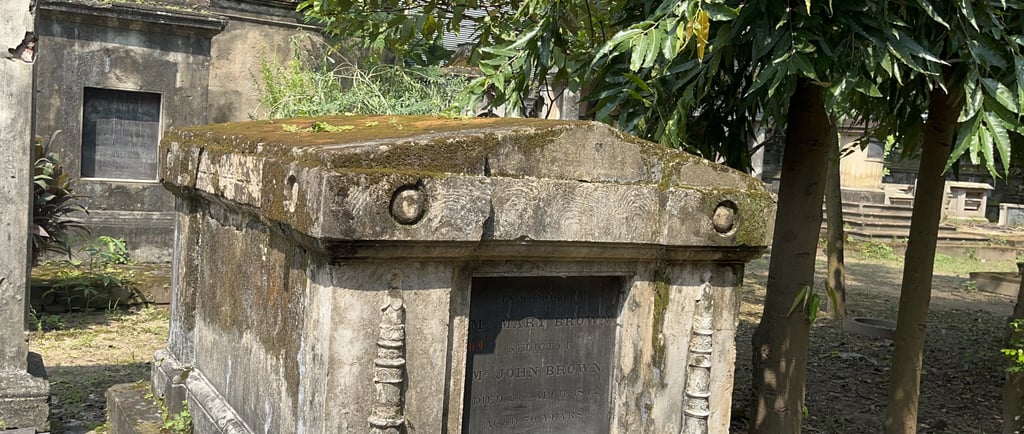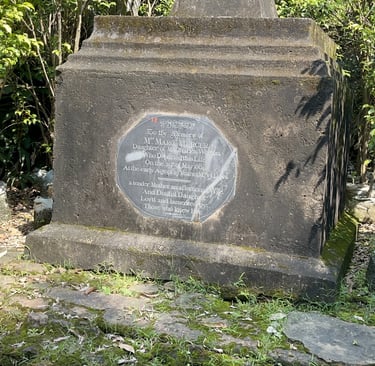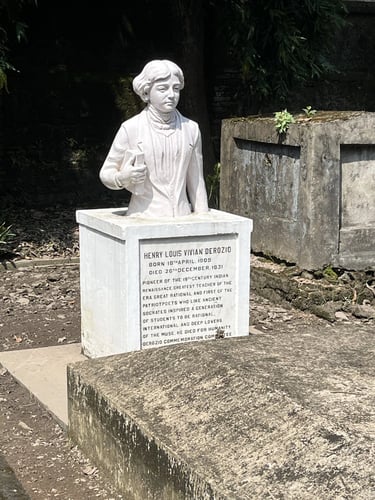South Park Street Cemetery Kolkata: Famous Graves and Stories
Discover the famous graves and untold stories of South Park Street Cemetery, Kolkata — a peaceful heritage site where poets, scholars, and visionaries rest in timeless silence.
WEST BENGAL
Arghyaraj Basu
10/21/20254 min read


On a breezy October afternoon, I finally crossed something off my long list of places I’d always wanted to visit the South Park Street Cemetery in Kolkata. Ever since I watched Gorosthan Sabdhan, the Feluda detective movie by Sandip Ray, I had dreamt of walking through this hauntingly beautiful place where mystery, memory, and history meet.
That film had made the cemetery come alive the misty tombs, the whispering trees, and the feeling that stories still breathe in the silence. And now, years later, I found myself standing at the same gate where one of Bengal’s most loved detectives once walked on screen.



A Walk Through Time
Built in 1767, the South Park Street Cemetery is one of the oldest burial grounds outside Europe and one of the earliest Christian cemeteries in India. It was used until around 1790, when the British East India Company made Kolkata (then Calcutta) their capital.
Back then, diseases like malaria and cholera were common, and many British officers, writers, doctors, and scholars died young while serving in India. The cemetery became their final resting place far from their homeland, under the tropical sky.
The place is not just rows of graves it’s a gallery of history carved in stone. The tombs are shaped like pyramids, obelisks, and domes a mix of European neoclassical and Indian architectural styles. They are made from sandstone and lime, and though many are now covered in moss and creepers, they still stand tall after more than 250 years.
Famous People Who Rest Here
As I walked deeper into the cemetery, every tomb seemed to whisper a story. Some names are well known people who helped shape Kolkata’s early history and culture.
• Henry Louis Vivian Derozio (1809–1831): The fiery young poet, teacher, and thinker who started the Bengal Renaissance. He inspired his students to think freely and question traditions. Derozio died at only 22, but his ideas still live on.
• Michael Madhusudan Dutt (1824–1873): One of Bengal’s greatest poets. He introduced blank verse to Bengali poetry and wrote Meghnad Badh Kavya. His grave is simple, but visitors still leave flowers there as a mark of respect.
• Sir William Jones (1746–1794): The founder of the Asiatic Society of Bengal, and one of the first scholars to study Sanskrit. He discovered similarities between Sanskrit, Greek, and Latin, which later helped build the science of linguistics.
• Charles Stuart (1758–1828): Known as Hindoo Stuart, he admired Indian traditions and even adopted Hindu customs. His tomb reflects his love for Indian culture a true symbol of cross-cultural respect.
• Rose Aylmer (1779–1800): A young English girl who died of cholera in Calcutta. The poet Walter Savage Landor wrote a touching poem about her, making her one of the most remembered names in the cemetery.
Each grave here has a story of ambition, love, loss, and discovery. Many inscriptions are still readable, telling tales of young officers, doctors, and families who came to India hoping to build a new life, but found eternal rest instead.
A Place Between Life and Stillness
There’s something haunting yet peaceful about Park Street Cemetery. It doesn’t feel spooky rather, it feels thoughtful. The old banyan trees form a green canopy overhead, sunlight peeking through in golden rays. Birds sing softly, and the only sounds are the crunch of leaves under your feet and the wind brushing past ancient stones.
Nature has quietly taken over moss, ferns, and vines wrap around the tombs like gentle arms. Yet the stones still speak, reminding us that time moves on, but memories remain.
The Feluda Connection: Gorosthan Sabdhan
For many Bengalis, Park Street Cemetery isn’t just a historical site it’s also part of our pop culture memory. Sandip Ray’s film Gorosthan Sabdhan (2010), based on Satyajit Ray’s Feluda story, was shot here.
The scenes featuring Feluda, Topshe, and Jatayu walking through the tombs gave the cemetery an air of adventure and mystery. For anyone who grew up loving Feluda, visiting the same spot feels magical as if fiction and reality gently overlap.
The City’s Memory Keeper
For Kolkata, the cemetery is more than a burial ground it’s a living museum. It tells the story of the city’s birth, its colonial past, and the people who helped shape it. Historians, photographers, artists, and travelers often visit to capture its quiet beauty and historical value.
The Archaeological Survey of India (ASI) now maintains the cemetery, keeping its heritage alive while allowing nature to breathe freely through it. Visiting it is not just about sightseeing it’s about feeling a connection to the layers of Kolkata’s past.
Leaving Through the Iron Gates
As I left through the old iron gate, I looked back one last time. The sun was dipping low, and the long shadows between the graves seemed to stretch endlessly. For a moment, I felt like I had been somewhere between the world of the living and the memories of the dead.
Stepping back onto Park Street, with its cafes, music, and laughter, I realized how beautifully Kolkata balances the old and the new. The cemetery stands as a gentle reminder that every city has its silences, and sometimes, silence speaks the loudest.
📍Location: South Park Street Cemetery, Kolkata
🕰️ Timings: 10 AM – 5 PM (Closed on Sundays and public holidays)
🎟️ Entry Fee: ₹25 per person
🎬 Notable Film: Gorosthan Sabdhan (2010), part of the Feluda series filmed here
📸 Photography: Allowed with permission


